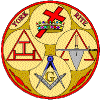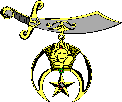For more information, see:
Related Topics:

There are many branches to the tree ...
![]()
The Masonic 'Family' has many parts and it can be confusing at times. We'll give you the basics along with some clarification.
Masonry - also known as Freemasonry. "The" organization! Sometimes referred to as the 'Blue Lodge' (because Masonic allegory makes a reference to the 'covering' of the lodge being the star-decked canopy of the heavens) but more properly called the 'Craft Lodge' since the 'craft' of Freemasonry is taught and learned there, Masonry has three 'degrees':
In some jurisdictions, one is a Mason when they first become an Entered Apprentice while in others, one must be a Master Mason. Regardless, all regular Masonic bodies consider the degree of Master Mason to be the 'highest degree' of Masonry. There is none 'higher'! The degrees are sometimes referred to by their numerical sequence: first, second, third. |
| Here's how the Masonic Information Center explains it: A degree is a stage or level of membership. It's also the ceremony by which a man attains that level of membership. There are three, called Entered Apprentice, Fellowcraft, and Master Mason. As you can see, the names are taken from the craft guilds. In the Middle Ages when a person wanted to join a craft, such as the gold smiths or the carpenters or the stonemasons, he was first apprenticed. As an apprentice, he learned the tools and skills of the trade. When he had proved his skills, he became a "Fellow of the Craft" (today we would say Journeyman"), and when he had exceptional ability, he was known as a Master of the Craft. The degrees are plays in which the candidate participates. Each degree uses symbols to teach, just as plays did in the Middle Ages and as many theatrical productions do today. The Masonic degrees teach the great lessons of life--the importance of honor and integrity, of being a person on whom others can rely, of being both trusting and trustworthy, of realizing that you have a spiritual nature as well as a physical or animal nature, of the importance of self-control, of knowing how to love and be loved, of knowing how to keep confidential what others tell you so they can "open up" without fear. Masonic Information Center |
.
Scottish Rite - As Freemasonry evolved through the centuries, some felt that additional instructions as to the various lessons taught in Craft Lodge. These would not make a man 'any more of a Mason' than he already was as a Master Mason, but would be an opportunity for additional contemplation on the lessons taught in the first three degrees. Scottish Rite degrees are numbered 4-33 with the 33rd Degree being honorary. As all Masons understand, a 32nd or 33rd Degree Mason is no 'more a Mason' than any Master Mason! In European Scottish Rite bodies, attainment of each degree may take months or years while in the United States, degrees are often conferred during special weekend 'convocations'. |

York Rite - Conceptually, the York Rite is similar to the Scottish Rite in that it provides an opportunity for additional contemplation on the lessons taught in Craft Masonry. There are fewer York Rite Degrees than Scottish Rite and they're not numbered. The 'apex' of York Rite Masonry is the degree of Knight Templar but again, a KT is no 'more a Mason' than that of Master Mason. |

Shrine - The 'playground of Masonry', Shrine was formed in the United States during last part of the nineteenth century by some New York Masons who wanted an organization which had at its foundation the principles of Masonry but without the solemnity of the Craft Lodge. One member of the group - an actor - suggested that a group be formed based on the (then) mysterious near East, complete with allusions to fezzes, camels, desert sands and other things pertaining to the fascinating area of northern Africa. With tales from sailors about their adventures and other lore of the time as a guide, the Shrine was born and instantly became a popular hit in the United States (although it has not received similar attention elsewhere in the world to this day!). Well known for their 22 Crippled Childrens' Hospitals and Burns Institutes which provide totally free care, the Shriners provide a very public view of Freemasonry. You can visit their web home page here. |
While there are Scottish and York Rite bodies throughout the world, Shrine is a North American experience with its focus in the United States.
In order to become a Shriner, one must be a Master Mason. Prior to 2000, it was also necessary to be a 32° Scottish Rite Mason or a Knight Templar (York Rite) Mason. That requirement, however, has been dropped.
![]()
In addition to the bodies above, there are other 'appendant' organizations which are 'related' to Freemasonry. These include Grotto, Tall Cedars of Lebanon, Order of Eastern Star, Job's Daughters, Rainbow, DeMolay, National Sojourners, High Twelve, and more.
Beyond that, there are organizations of Masons and those related to Masonry which are Masonic in character but which are formed to encourage those with like interests. There's a US national camper-trailer organization composed of Masons and their families, there are organizations of Masonic police officers, and many, many others. Freemasonry strives to encourage good works and groups such as these are one way of achieving that goal.
![]()










